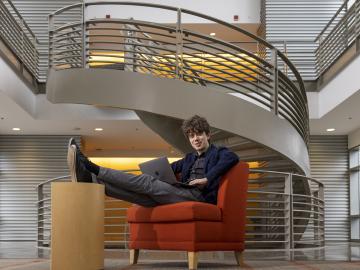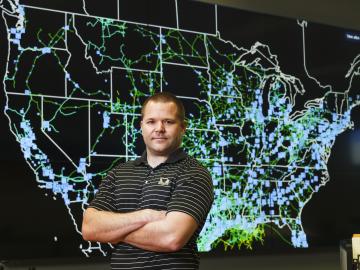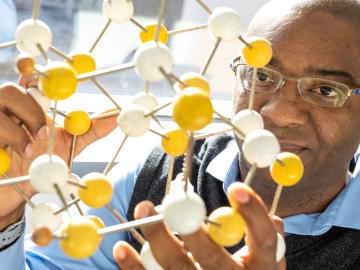Filter News
Area of Research
News Topics
- 3-D Printing/Advanced Manufacturing (11)
- Advanced Reactors (4)
- Artificial Intelligence (5)
- Big Data (6)
- Bioenergy (6)
- Biology (2)
- Biomedical (10)
- Biotechnology (1)
- Chemical Sciences (2)
- Clean Water (2)
- Computer Science (19)
- Coronavirus (11)
- Cybersecurity (2)
- Energy Storage (7)
- Environment (8)
- Exascale Computing (2)
- Fusion (9)
- Grid (3)
- High-Performance Computing (1)
- Isotopes (3)
- Machine Learning (2)
- Materials Science (11)
- Mathematics (2)
- Mercury (1)
- Microscopy (3)
- Nanotechnology (3)
- Neutron Science (9)
- Nuclear Energy (17)
- Physics (8)
- Polymers (1)
- Quantum Science (6)
- Security (2)
- Space Exploration (1)
- Summit (7)
- Sustainable Energy (4)
- Transformational Challenge Reactor (3)
- Transportation (5)
Media Contacts

Joe Paddison, a Eugene P. Wigner Fellow at the Department of Energy’s Oak Ridge National Laboratory, believes there’s more information to be found in neutron scattering data than scientists like himself might expect.

Biological membranes, such as the “walls” of most types of living cells, primarily consist of a double layer of lipids, or “lipid bilayer,” that forms the structure, and a variety of embedded and attached proteins with highly specialized functions, including proteins that rapidly and selectively transport ions and molecules in and out of the cell.

Nils Stenvig has always had an interest in solving big problems. That desire drove his focus on electrical engineering in college and eventually led him to Oak Ridge National Laboratory, where today he’s using his expertise to better understand the world’s largest machine—the electrical grid.

Scientists at the Department of Energy’s Oak Ridge National Laboratory have developed a new method to peer deep into the nanostructure of biomaterials without damaging the sample. This novel technique can confirm structural features in starch, a carbohydrate important in biofuel production.

Valentino (“Tino”) Cooper of the Department of Energy’s Oak Ridge National Laboratory uses theory, modeling and computation to improve fundamental understanding of advanced materials for next-generation energy and information technologies.

We have a data problem. Humanity is now generating more data than it can handle; more sensors, smartphones, and devices of all types are coming online every day and contributing to the ever-growing global dataset.

Each year, approximately 6 billion gallons of fuel are wasted as vehicles wait at stop lights or sit in dense traffic with engines idling, according to US Department of Energy estimates.

As a reactor physics nuclear engineer, Ben Betzler leverages and develops computational methods to solve questions across nuclear energy—whether it’s finding the best design of a reactor core or repurposing an old tool for a new analysis.

As the second-leading cause of death in the United States, cancer is a public health crisis that afflicts nearly one in two people during their lifetime.

Peter Wang is focused on robotics and automation at the Department of Energy’s Manufacturing Demonstration Facility at ORNL, working on high-profile projects such as the MedUSA, a large-scale hybrid additive manufacturing machine.




